MGMT6014 - PepsiCo Inc: Future-Proofing Through Benchmarking Analysis
VerifiedAdded on 2023/06/12
|10
|2341
|220
Report
AI Summary
This report assesses PepsiCo Inc's future prospects in the food and beverage industry, focusing on strategies for future-proofing the organization through benchmarking. It identifies potential future states influenced by technological changes, increased competition, and the need for business sustainability. The report emphasizes enhancing organizational culture, diversifying products, and focusing on recycling to address plastic pollution. It recommends internal, competitive, and function/process benchmarking to ensure a sustained competitive advantage. The analysis considers economic, social, and environmental factors impacting PepsiCo's operations in Australia, highlighting the importance of adapting to changing consumer needs and environmental concerns. The document is available on Desklib, which offers a range of study resources including past papers and solved assignments.
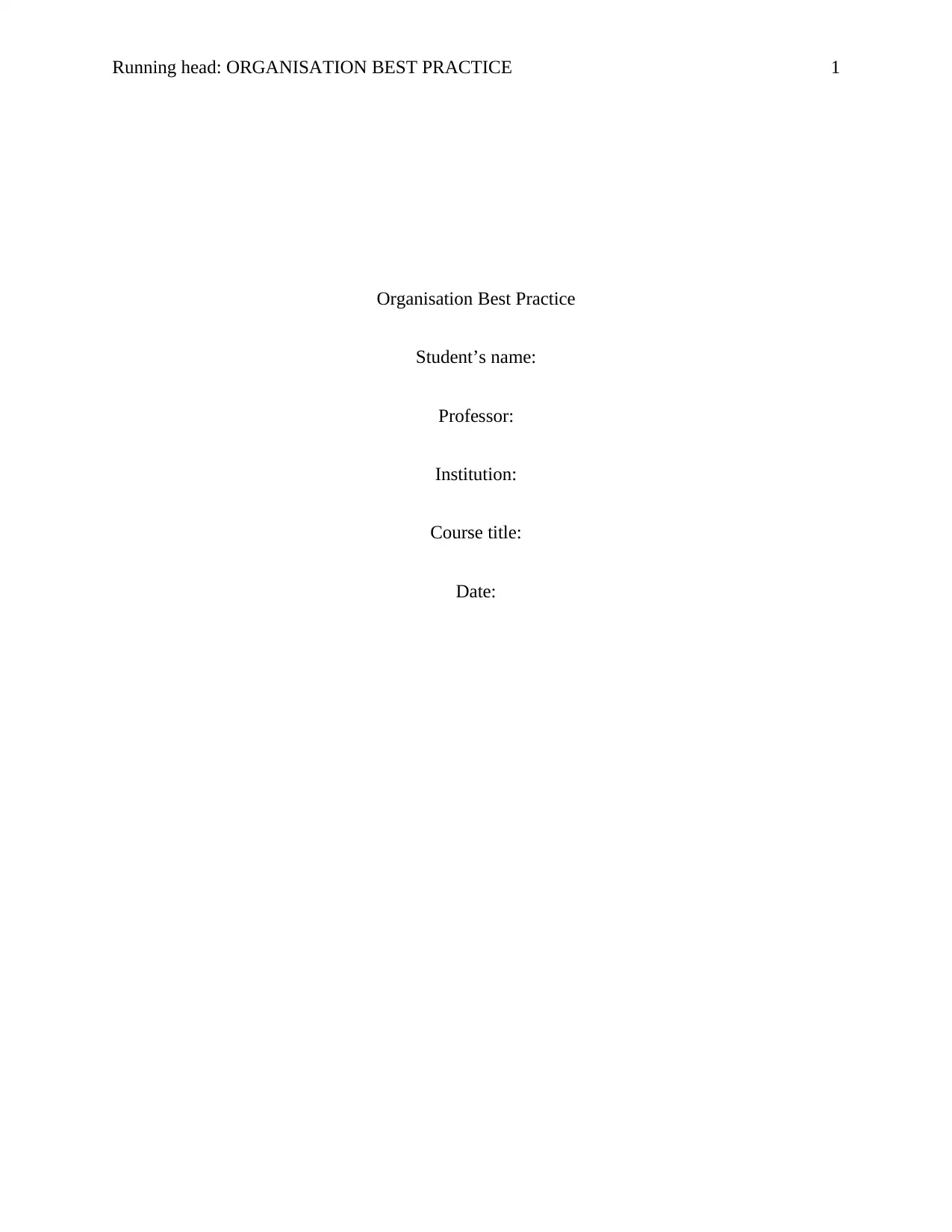
Running head: ORGANISATION BEST PRACTICE 1
Organisation Best Practice
Student’s name:
Professor:
Institution:
Course title:
Date:
Organisation Best Practice
Student’s name:
Professor:
Institution:
Course title:
Date:
Paraphrase This Document
Need a fresh take? Get an instant paraphrase of this document with our AI Paraphraser
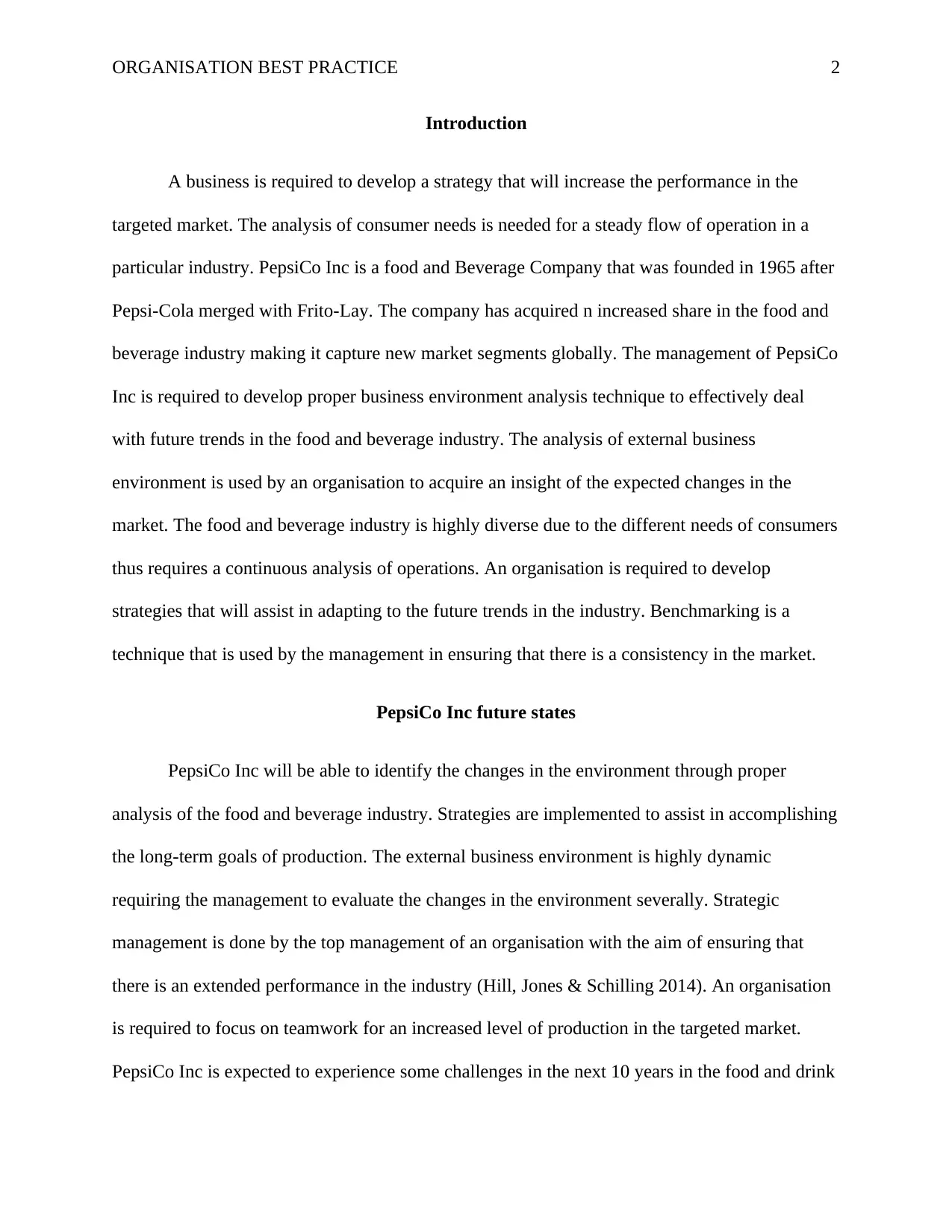
ORGANISATION BEST PRACTICE 2
Introduction
A business is required to develop a strategy that will increase the performance in the
targeted market. The analysis of consumer needs is needed for a steady flow of operation in a
particular industry. PepsiCo Inc is a food and Beverage Company that was founded in 1965 after
Pepsi-Cola merged with Frito-Lay. The company has acquired n increased share in the food and
beverage industry making it capture new market segments globally. The management of PepsiCo
Inc is required to develop proper business environment analysis technique to effectively deal
with future trends in the food and beverage industry. The analysis of external business
environment is used by an organisation to acquire an insight of the expected changes in the
market. The food and beverage industry is highly diverse due to the different needs of consumers
thus requires a continuous analysis of operations. An organisation is required to develop
strategies that will assist in adapting to the future trends in the industry. Benchmarking is a
technique that is used by the management in ensuring that there is a consistency in the market.
PepsiCo Inc future states
PepsiCo Inc will be able to identify the changes in the environment through proper
analysis of the food and beverage industry. Strategies are implemented to assist in accomplishing
the long-term goals of production. The external business environment is highly dynamic
requiring the management to evaluate the changes in the environment severally. Strategic
management is done by the top management of an organisation with the aim of ensuring that
there is an extended performance in the industry (Hill, Jones & Schilling 2014). An organisation
is required to focus on teamwork for an increased level of production in the targeted market.
PepsiCo Inc is expected to experience some challenges in the next 10 years in the food and drink
Introduction
A business is required to develop a strategy that will increase the performance in the
targeted market. The analysis of consumer needs is needed for a steady flow of operation in a
particular industry. PepsiCo Inc is a food and Beverage Company that was founded in 1965 after
Pepsi-Cola merged with Frito-Lay. The company has acquired n increased share in the food and
beverage industry making it capture new market segments globally. The management of PepsiCo
Inc is required to develop proper business environment analysis technique to effectively deal
with future trends in the food and beverage industry. The analysis of external business
environment is used by an organisation to acquire an insight of the expected changes in the
market. The food and beverage industry is highly diverse due to the different needs of consumers
thus requires a continuous analysis of operations. An organisation is required to develop
strategies that will assist in adapting to the future trends in the industry. Benchmarking is a
technique that is used by the management in ensuring that there is a consistency in the market.
PepsiCo Inc future states
PepsiCo Inc will be able to identify the changes in the environment through proper
analysis of the food and beverage industry. Strategies are implemented to assist in accomplishing
the long-term goals of production. The external business environment is highly dynamic
requiring the management to evaluate the changes in the environment severally. Strategic
management is done by the top management of an organisation with the aim of ensuring that
there is an extended performance in the industry (Hill, Jones & Schilling 2014). An organisation
is required to focus on teamwork for an increased level of production in the targeted market.
PepsiCo Inc is expected to experience some challenges in the next 10 years in the food and drink
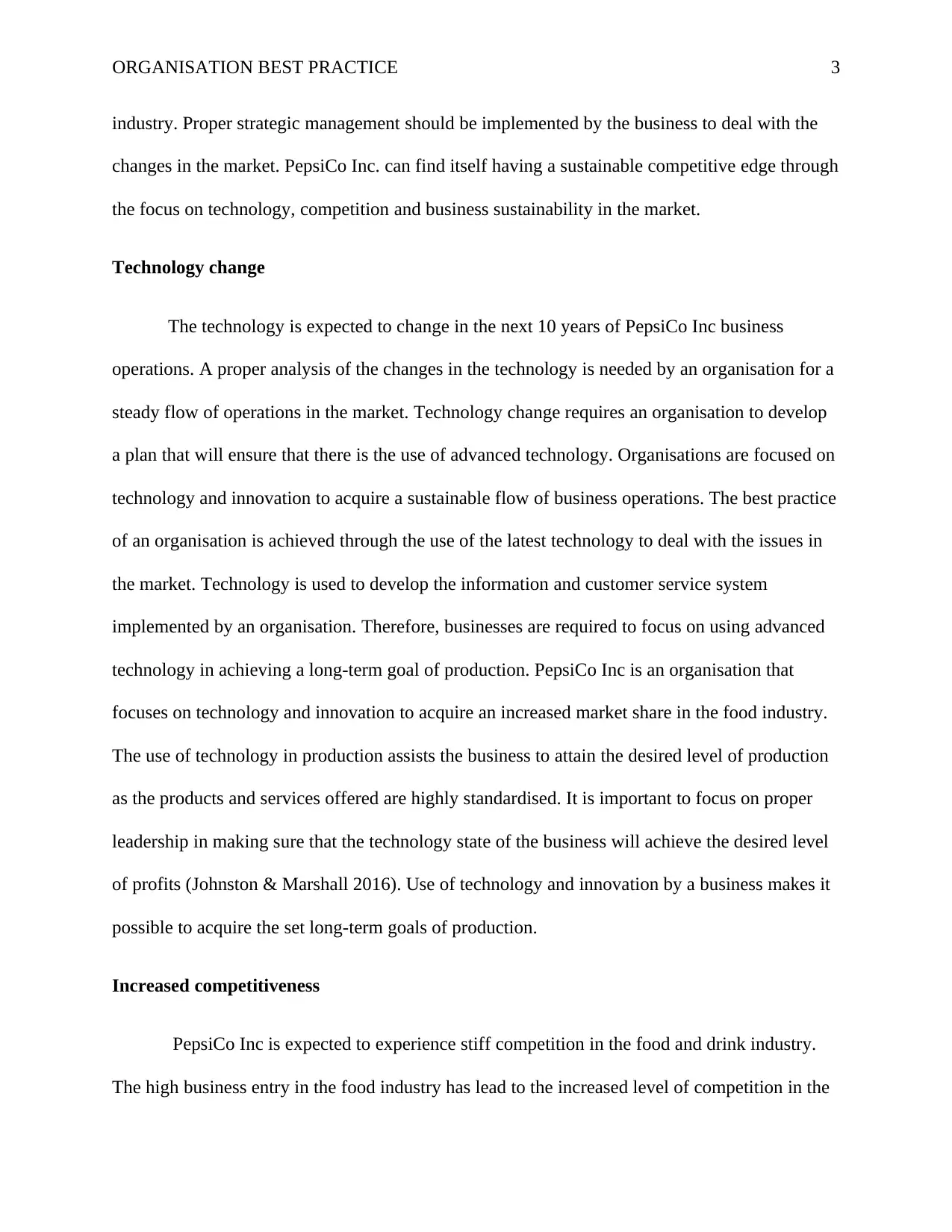
ORGANISATION BEST PRACTICE 3
industry. Proper strategic management should be implemented by the business to deal with the
changes in the market. PepsiCo Inc. can find itself having a sustainable competitive edge through
the focus on technology, competition and business sustainability in the market.
Technology change
The technology is expected to change in the next 10 years of PepsiCo Inc business
operations. A proper analysis of the changes in the technology is needed by an organisation for a
steady flow of operations in the market. Technology change requires an organisation to develop
a plan that will ensure that there is the use of advanced technology. Organisations are focused on
technology and innovation to acquire a sustainable flow of business operations. The best practice
of an organisation is achieved through the use of the latest technology to deal with the issues in
the market. Technology is used to develop the information and customer service system
implemented by an organisation. Therefore, businesses are required to focus on using advanced
technology in achieving a long-term goal of production. PepsiCo Inc is an organisation that
focuses on technology and innovation to acquire an increased market share in the food industry.
The use of technology in production assists the business to attain the desired level of production
as the products and services offered are highly standardised. It is important to focus on proper
leadership in making sure that the technology state of the business will achieve the desired level
of profits (Johnston & Marshall 2016). Use of technology and innovation by a business makes it
possible to acquire the set long-term goals of production.
Increased competitiveness
PepsiCo Inc is expected to experience stiff competition in the food and drink industry.
The high business entry in the food industry has lead to the increased level of competition in the
industry. Proper strategic management should be implemented by the business to deal with the
changes in the market. PepsiCo Inc. can find itself having a sustainable competitive edge through
the focus on technology, competition and business sustainability in the market.
Technology change
The technology is expected to change in the next 10 years of PepsiCo Inc business
operations. A proper analysis of the changes in the technology is needed by an organisation for a
steady flow of operations in the market. Technology change requires an organisation to develop
a plan that will ensure that there is the use of advanced technology. Organisations are focused on
technology and innovation to acquire a sustainable flow of business operations. The best practice
of an organisation is achieved through the use of the latest technology to deal with the issues in
the market. Technology is used to develop the information and customer service system
implemented by an organisation. Therefore, businesses are required to focus on using advanced
technology in achieving a long-term goal of production. PepsiCo Inc is an organisation that
focuses on technology and innovation to acquire an increased market share in the food industry.
The use of technology in production assists the business to attain the desired level of production
as the products and services offered are highly standardised. It is important to focus on proper
leadership in making sure that the technology state of the business will achieve the desired level
of profits (Johnston & Marshall 2016). Use of technology and innovation by a business makes it
possible to acquire the set long-term goals of production.
Increased competitiveness
PepsiCo Inc is expected to experience stiff competition in the food and drink industry.
The high business entry in the food industry has lead to the increased level of competition in the
⊘ This is a preview!⊘
Do you want full access?
Subscribe today to unlock all pages.

Trusted by 1+ million students worldwide
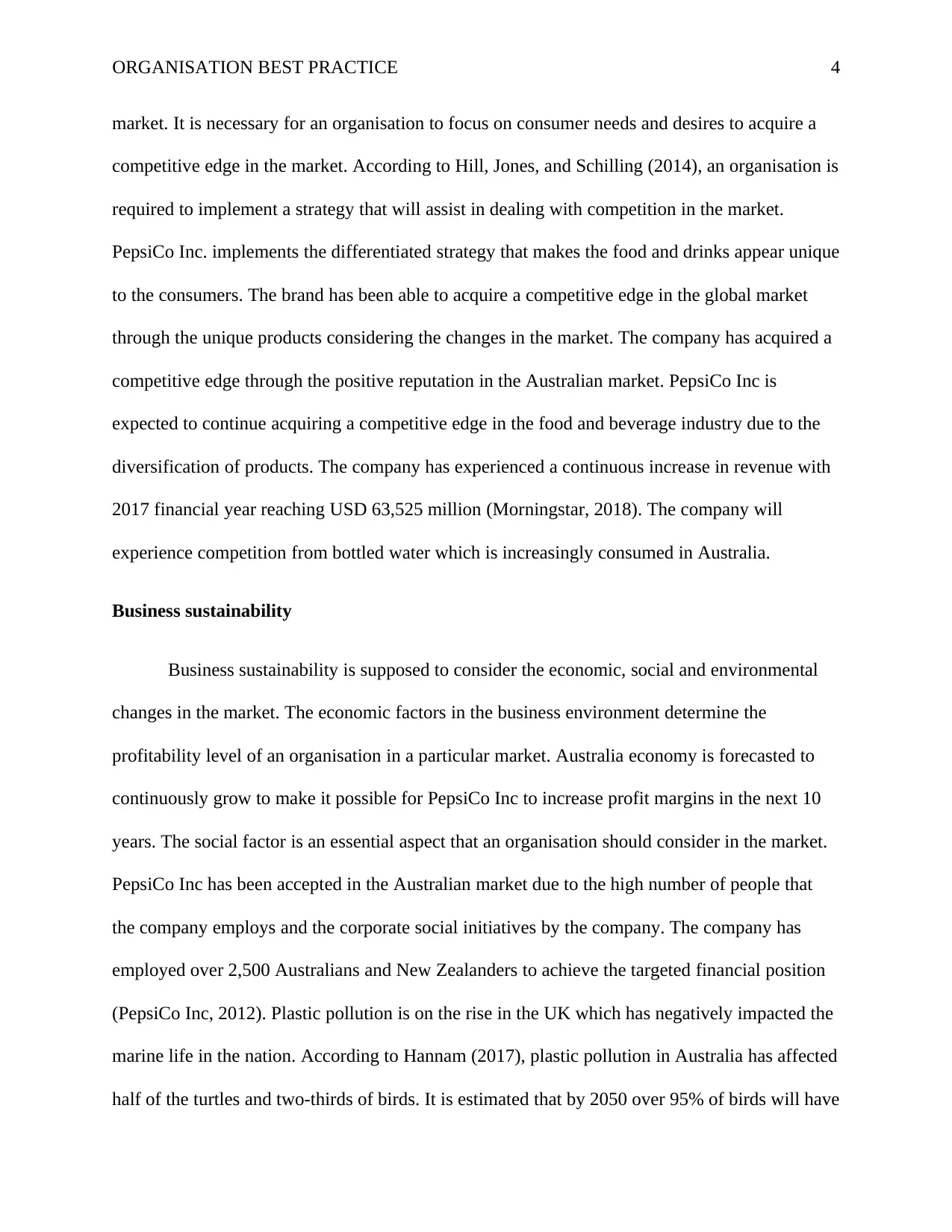
ORGANISATION BEST PRACTICE 4
market. It is necessary for an organisation to focus on consumer needs and desires to acquire a
competitive edge in the market. According to Hill, Jones, and Schilling (2014), an organisation is
required to implement a strategy that will assist in dealing with competition in the market.
PepsiCo Inc. implements the differentiated strategy that makes the food and drinks appear unique
to the consumers. The brand has been able to acquire a competitive edge in the global market
through the unique products considering the changes in the market. The company has acquired a
competitive edge through the positive reputation in the Australian market. PepsiCo Inc is
expected to continue acquiring a competitive edge in the food and beverage industry due to the
diversification of products. The company has experienced a continuous increase in revenue with
2017 financial year reaching USD 63,525 million (Morningstar, 2018). The company will
experience competition from bottled water which is increasingly consumed in Australia.
Business sustainability
Business sustainability is supposed to consider the economic, social and environmental
changes in the market. The economic factors in the business environment determine the
profitability level of an organisation in a particular market. Australia economy is forecasted to
continuously grow to make it possible for PepsiCo Inc to increase profit margins in the next 10
years. The social factor is an essential aspect that an organisation should consider in the market.
PepsiCo Inc has been accepted in the Australian market due to the high number of people that
the company employs and the corporate social initiatives by the company. The company has
employed over 2,500 Australians and New Zealanders to achieve the targeted financial position
(PepsiCo Inc, 2012). Plastic pollution is on the rise in the UK which has negatively impacted the
marine life in the nation. According to Hannam (2017), plastic pollution in Australia has affected
half of the turtles and two-thirds of birds. It is estimated that by 2050 over 95% of birds will have
market. It is necessary for an organisation to focus on consumer needs and desires to acquire a
competitive edge in the market. According to Hill, Jones, and Schilling (2014), an organisation is
required to implement a strategy that will assist in dealing with competition in the market.
PepsiCo Inc. implements the differentiated strategy that makes the food and drinks appear unique
to the consumers. The brand has been able to acquire a competitive edge in the global market
through the unique products considering the changes in the market. The company has acquired a
competitive edge through the positive reputation in the Australian market. PepsiCo Inc is
expected to continue acquiring a competitive edge in the food and beverage industry due to the
diversification of products. The company has experienced a continuous increase in revenue with
2017 financial year reaching USD 63,525 million (Morningstar, 2018). The company will
experience competition from bottled water which is increasingly consumed in Australia.
Business sustainability
Business sustainability is supposed to consider the economic, social and environmental
changes in the market. The economic factors in the business environment determine the
profitability level of an organisation in a particular market. Australia economy is forecasted to
continuously grow to make it possible for PepsiCo Inc to increase profit margins in the next 10
years. The social factor is an essential aspect that an organisation should consider in the market.
PepsiCo Inc has been accepted in the Australian market due to the high number of people that
the company employs and the corporate social initiatives by the company. The company has
employed over 2,500 Australians and New Zealanders to achieve the targeted financial position
(PepsiCo Inc, 2012). Plastic pollution is on the rise in the UK which has negatively impacted the
marine life in the nation. According to Hannam (2017), plastic pollution in Australia has affected
half of the turtles and two-thirds of birds. It is estimated that by 2050 over 95% of birds will have
Paraphrase This Document
Need a fresh take? Get an instant paraphrase of this document with our AI Paraphraser
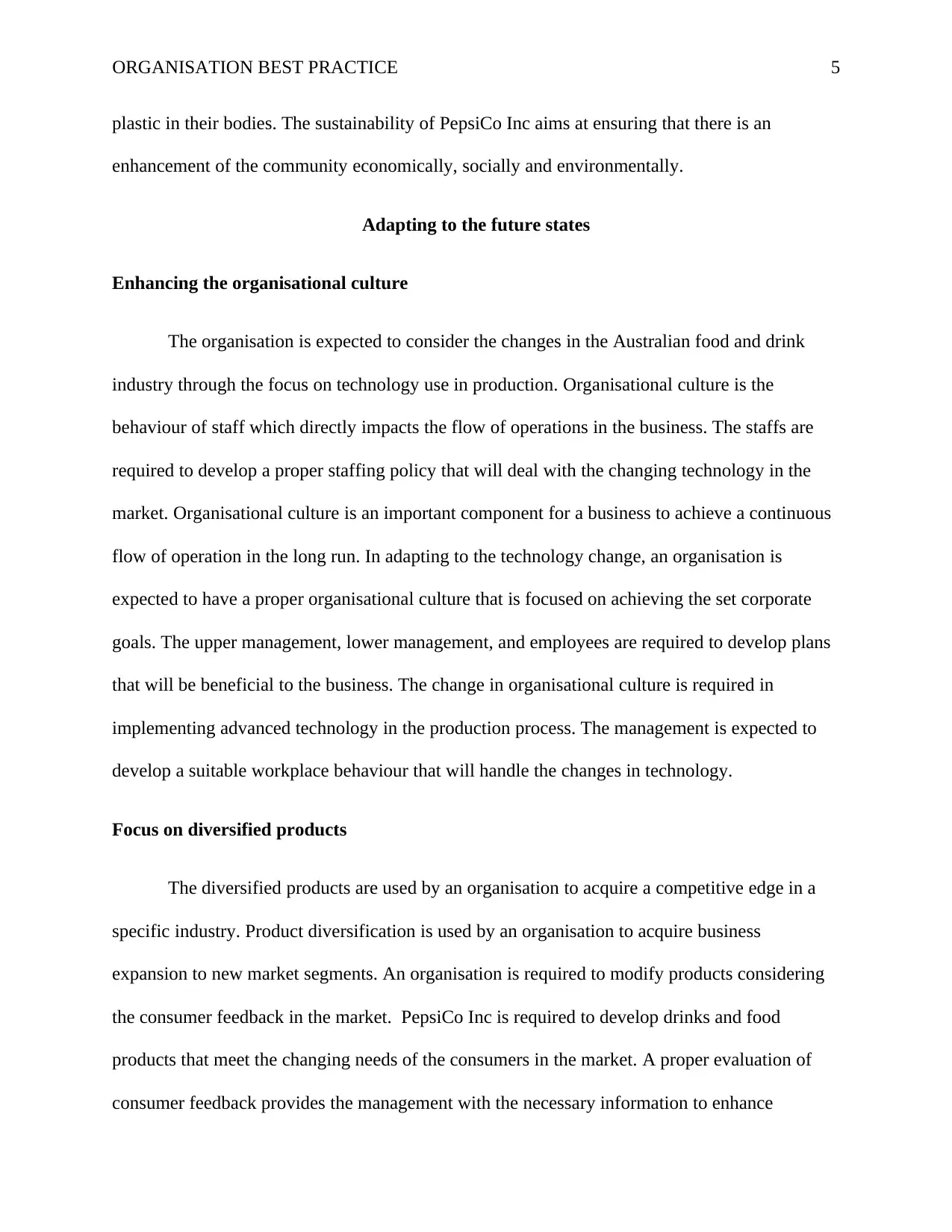
ORGANISATION BEST PRACTICE 5
plastic in their bodies. The sustainability of PepsiCo Inc aims at ensuring that there is an
enhancement of the community economically, socially and environmentally.
Adapting to the future states
Enhancing the organisational culture
The organisation is expected to consider the changes in the Australian food and drink
industry through the focus on technology use in production. Organisational culture is the
behaviour of staff which directly impacts the flow of operations in the business. The staffs are
required to develop a proper staffing policy that will deal with the changing technology in the
market. Organisational culture is an important component for a business to achieve a continuous
flow of operation in the long run. In adapting to the technology change, an organisation is
expected to have a proper organisational culture that is focused on achieving the set corporate
goals. The upper management, lower management, and employees are required to develop plans
that will be beneficial to the business. The change in organisational culture is required in
implementing advanced technology in the production process. The management is expected to
develop a suitable workplace behaviour that will handle the changes in technology.
Focus on diversified products
The diversified products are used by an organisation to acquire a competitive edge in a
specific industry. Product diversification is used by an organisation to acquire business
expansion to new market segments. An organisation is required to modify products considering
the consumer feedback in the market. PepsiCo Inc is required to develop drinks and food
products that meet the changing needs of the consumers in the market. A proper evaluation of
consumer feedback provides the management with the necessary information to enhance
plastic in their bodies. The sustainability of PepsiCo Inc aims at ensuring that there is an
enhancement of the community economically, socially and environmentally.
Adapting to the future states
Enhancing the organisational culture
The organisation is expected to consider the changes in the Australian food and drink
industry through the focus on technology use in production. Organisational culture is the
behaviour of staff which directly impacts the flow of operations in the business. The staffs are
required to develop a proper staffing policy that will deal with the changing technology in the
market. Organisational culture is an important component for a business to achieve a continuous
flow of operation in the long run. In adapting to the technology change, an organisation is
expected to have a proper organisational culture that is focused on achieving the set corporate
goals. The upper management, lower management, and employees are required to develop plans
that will be beneficial to the business. The change in organisational culture is required in
implementing advanced technology in the production process. The management is expected to
develop a suitable workplace behaviour that will handle the changes in technology.
Focus on diversified products
The diversified products are used by an organisation to acquire a competitive edge in a
specific industry. Product diversification is used by an organisation to acquire business
expansion to new market segments. An organisation is required to modify products considering
the consumer feedback in the market. PepsiCo Inc is required to develop drinks and food
products that meet the changing needs of the consumers in the market. A proper evaluation of
consumer feedback provides the management with the necessary information to enhance
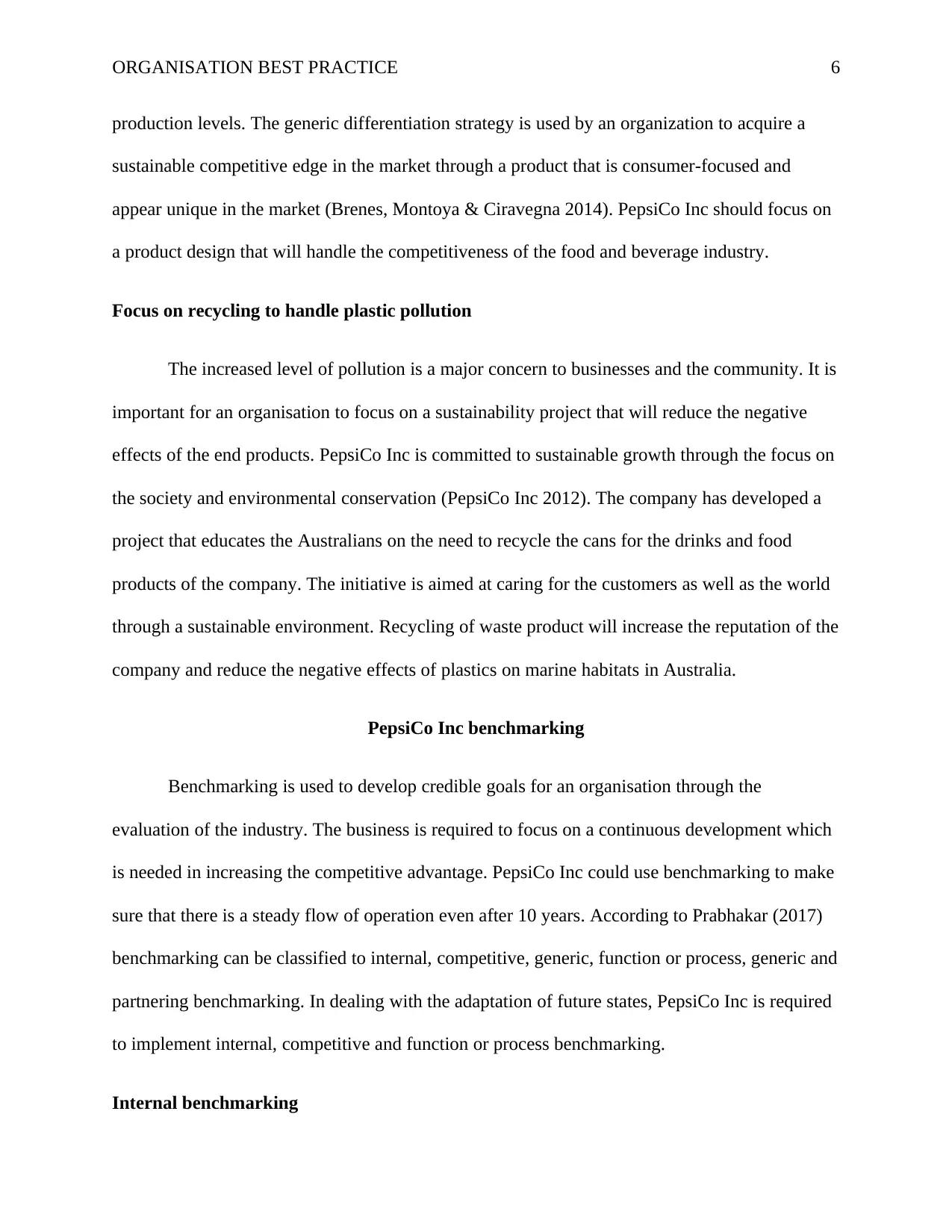
ORGANISATION BEST PRACTICE 6
production levels. The generic differentiation strategy is used by an organization to acquire a
sustainable competitive edge in the market through a product that is consumer-focused and
appear unique in the market (Brenes, Montoya & Ciravegna 2014). PepsiCo Inc should focus on
a product design that will handle the competitiveness of the food and beverage industry.
Focus on recycling to handle plastic pollution
The increased level of pollution is a major concern to businesses and the community. It is
important for an organisation to focus on a sustainability project that will reduce the negative
effects of the end products. PepsiCo Inc is committed to sustainable growth through the focus on
the society and environmental conservation (PepsiCo Inc 2012). The company has developed a
project that educates the Australians on the need to recycle the cans for the drinks and food
products of the company. The initiative is aimed at caring for the customers as well as the world
through a sustainable environment. Recycling of waste product will increase the reputation of the
company and reduce the negative effects of plastics on marine habitats in Australia.
PepsiCo Inc benchmarking
Benchmarking is used to develop credible goals for an organisation through the
evaluation of the industry. The business is required to focus on a continuous development which
is needed in increasing the competitive advantage. PepsiCo Inc could use benchmarking to make
sure that there is a steady flow of operation even after 10 years. According to Prabhakar (2017)
benchmarking can be classified to internal, competitive, generic, function or process, generic and
partnering benchmarking. In dealing with the adaptation of future states, PepsiCo Inc is required
to implement internal, competitive and function or process benchmarking.
Internal benchmarking
production levels. The generic differentiation strategy is used by an organization to acquire a
sustainable competitive edge in the market through a product that is consumer-focused and
appear unique in the market (Brenes, Montoya & Ciravegna 2014). PepsiCo Inc should focus on
a product design that will handle the competitiveness of the food and beverage industry.
Focus on recycling to handle plastic pollution
The increased level of pollution is a major concern to businesses and the community. It is
important for an organisation to focus on a sustainability project that will reduce the negative
effects of the end products. PepsiCo Inc is committed to sustainable growth through the focus on
the society and environmental conservation (PepsiCo Inc 2012). The company has developed a
project that educates the Australians on the need to recycle the cans for the drinks and food
products of the company. The initiative is aimed at caring for the customers as well as the world
through a sustainable environment. Recycling of waste product will increase the reputation of the
company and reduce the negative effects of plastics on marine habitats in Australia.
PepsiCo Inc benchmarking
Benchmarking is used to develop credible goals for an organisation through the
evaluation of the industry. The business is required to focus on a continuous development which
is needed in increasing the competitive advantage. PepsiCo Inc could use benchmarking to make
sure that there is a steady flow of operation even after 10 years. According to Prabhakar (2017)
benchmarking can be classified to internal, competitive, generic, function or process, generic and
partnering benchmarking. In dealing with the adaptation of future states, PepsiCo Inc is required
to implement internal, competitive and function or process benchmarking.
Internal benchmarking
⊘ This is a preview!⊘
Do you want full access?
Subscribe today to unlock all pages.

Trusted by 1+ million students worldwide
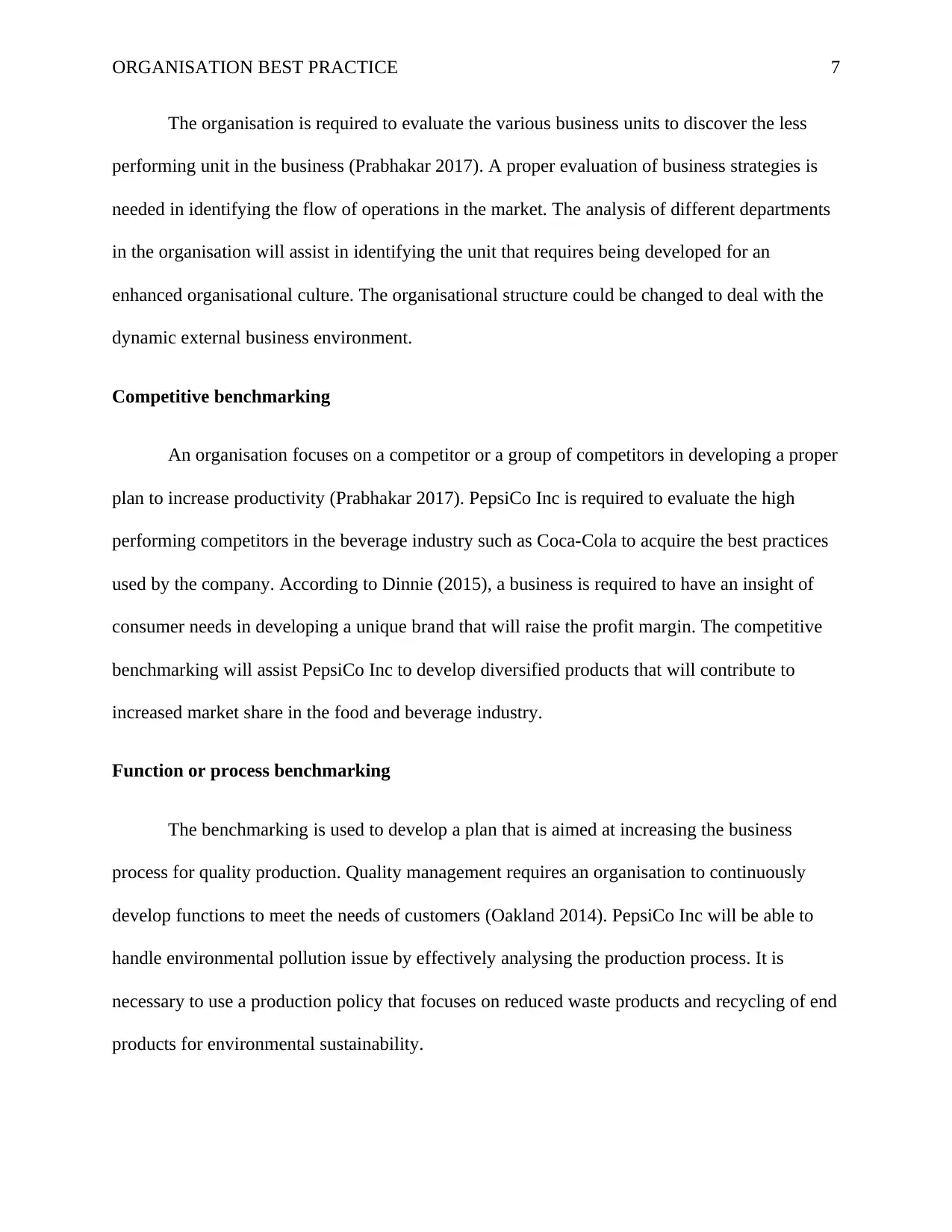
ORGANISATION BEST PRACTICE 7
The organisation is required to evaluate the various business units to discover the less
performing unit in the business (Prabhakar 2017). A proper evaluation of business strategies is
needed in identifying the flow of operations in the market. The analysis of different departments
in the organisation will assist in identifying the unit that requires being developed for an
enhanced organisational culture. The organisational structure could be changed to deal with the
dynamic external business environment.
Competitive benchmarking
An organisation focuses on a competitor or a group of competitors in developing a proper
plan to increase productivity (Prabhakar 2017). PepsiCo Inc is required to evaluate the high
performing competitors in the beverage industry such as Coca-Cola to acquire the best practices
used by the company. According to Dinnie (2015), a business is required to have an insight of
consumer needs in developing a unique brand that will raise the profit margin. The competitive
benchmarking will assist PepsiCo Inc to develop diversified products that will contribute to
increased market share in the food and beverage industry.
Function or process benchmarking
The benchmarking is used to develop a plan that is aimed at increasing the business
process for quality production. Quality management requires an organisation to continuously
develop functions to meet the needs of customers (Oakland 2014). PepsiCo Inc will be able to
handle environmental pollution issue by effectively analysing the production process. It is
necessary to use a production policy that focuses on reduced waste products and recycling of end
products for environmental sustainability.
The organisation is required to evaluate the various business units to discover the less
performing unit in the business (Prabhakar 2017). A proper evaluation of business strategies is
needed in identifying the flow of operations in the market. The analysis of different departments
in the organisation will assist in identifying the unit that requires being developed for an
enhanced organisational culture. The organisational structure could be changed to deal with the
dynamic external business environment.
Competitive benchmarking
An organisation focuses on a competitor or a group of competitors in developing a proper
plan to increase productivity (Prabhakar 2017). PepsiCo Inc is required to evaluate the high
performing competitors in the beverage industry such as Coca-Cola to acquire the best practices
used by the company. According to Dinnie (2015), a business is required to have an insight of
consumer needs in developing a unique brand that will raise the profit margin. The competitive
benchmarking will assist PepsiCo Inc to develop diversified products that will contribute to
increased market share in the food and beverage industry.
Function or process benchmarking
The benchmarking is used to develop a plan that is aimed at increasing the business
process for quality production. Quality management requires an organisation to continuously
develop functions to meet the needs of customers (Oakland 2014). PepsiCo Inc will be able to
handle environmental pollution issue by effectively analysing the production process. It is
necessary to use a production policy that focuses on reduced waste products and recycling of end
products for environmental sustainability.
Paraphrase This Document
Need a fresh take? Get an instant paraphrase of this document with our AI Paraphraser
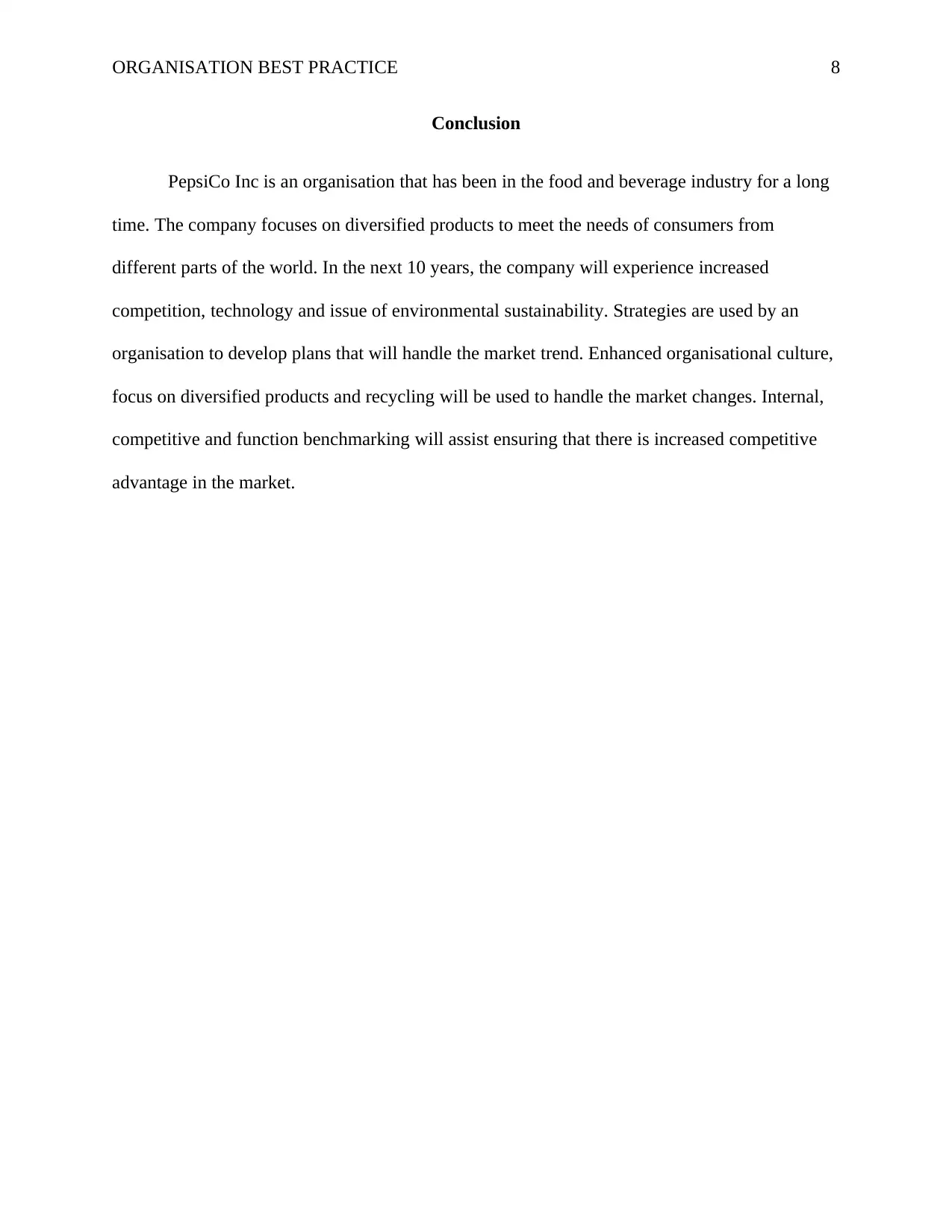
ORGANISATION BEST PRACTICE 8
Conclusion
PepsiCo Inc is an organisation that has been in the food and beverage industry for a long
time. The company focuses on diversified products to meet the needs of consumers from
different parts of the world. In the next 10 years, the company will experience increased
competition, technology and issue of environmental sustainability. Strategies are used by an
organisation to develop plans that will handle the market trend. Enhanced organisational culture,
focus on diversified products and recycling will be used to handle the market changes. Internal,
competitive and function benchmarking will assist ensuring that there is increased competitive
advantage in the market.
Conclusion
PepsiCo Inc is an organisation that has been in the food and beverage industry for a long
time. The company focuses on diversified products to meet the needs of consumers from
different parts of the world. In the next 10 years, the company will experience increased
competition, technology and issue of environmental sustainability. Strategies are used by an
organisation to develop plans that will handle the market trend. Enhanced organisational culture,
focus on diversified products and recycling will be used to handle the market changes. Internal,
competitive and function benchmarking will assist ensuring that there is increased competitive
advantage in the market.
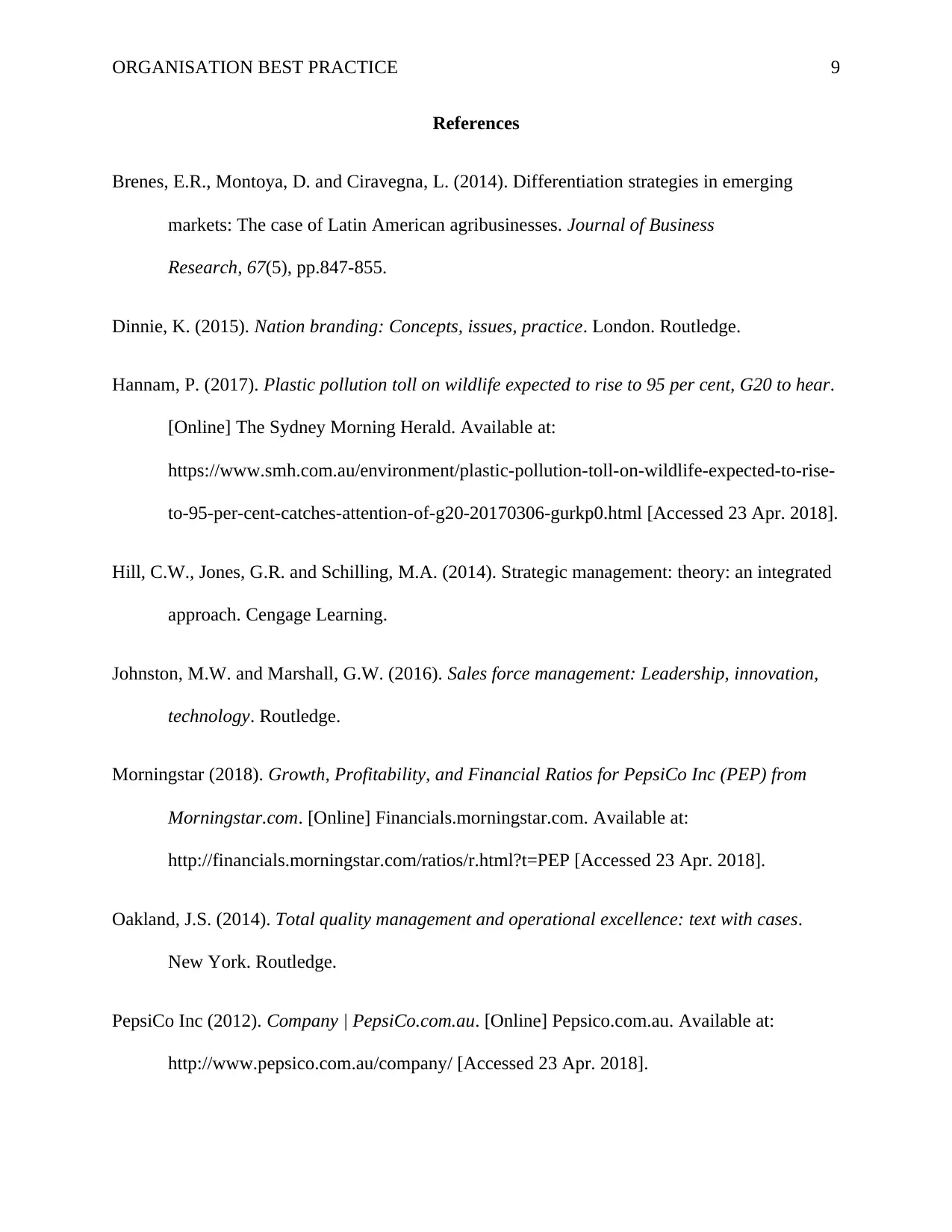
ORGANISATION BEST PRACTICE 9
References
Brenes, E.R., Montoya, D. and Ciravegna, L. (2014). Differentiation strategies in emerging
markets: The case of Latin American agribusinesses. Journal of Business
Research, 67(5), pp.847-855.
Dinnie, K. (2015). Nation branding: Concepts, issues, practice. London. Routledge.
Hannam, P. (2017). Plastic pollution toll on wildlife expected to rise to 95 per cent, G20 to hear.
[Online] The Sydney Morning Herald. Available at:
https://www.smh.com.au/environment/plastic-pollution-toll-on-wildlife-expected-to-rise-
to-95-per-cent-catches-attention-of-g20-20170306-gurkp0.html [Accessed 23 Apr. 2018].
Hill, C.W., Jones, G.R. and Schilling, M.A. (2014). Strategic management: theory: an integrated
approach. Cengage Learning.
Johnston, M.W. and Marshall, G.W. (2016). Sales force management: Leadership, innovation,
technology. Routledge.
Morningstar (2018). Growth, Profitability, and Financial Ratios for PepsiCo Inc (PEP) from
Morningstar.com. [Online] Financials.morningstar.com. Available at:
http://financials.morningstar.com/ratios/r.html?t=PEP [Accessed 23 Apr. 2018].
Oakland, J.S. (2014). Total quality management and operational excellence: text with cases.
New York. Routledge.
PepsiCo Inc (2012). Company | PepsiCo.com.au. [Online] Pepsico.com.au. Available at:
http://www.pepsico.com.au/company/ [Accessed 23 Apr. 2018].
References
Brenes, E.R., Montoya, D. and Ciravegna, L. (2014). Differentiation strategies in emerging
markets: The case of Latin American agribusinesses. Journal of Business
Research, 67(5), pp.847-855.
Dinnie, K. (2015). Nation branding: Concepts, issues, practice. London. Routledge.
Hannam, P. (2017). Plastic pollution toll on wildlife expected to rise to 95 per cent, G20 to hear.
[Online] The Sydney Morning Herald. Available at:
https://www.smh.com.au/environment/plastic-pollution-toll-on-wildlife-expected-to-rise-
to-95-per-cent-catches-attention-of-g20-20170306-gurkp0.html [Accessed 23 Apr. 2018].
Hill, C.W., Jones, G.R. and Schilling, M.A. (2014). Strategic management: theory: an integrated
approach. Cengage Learning.
Johnston, M.W. and Marshall, G.W. (2016). Sales force management: Leadership, innovation,
technology. Routledge.
Morningstar (2018). Growth, Profitability, and Financial Ratios for PepsiCo Inc (PEP) from
Morningstar.com. [Online] Financials.morningstar.com. Available at:
http://financials.morningstar.com/ratios/r.html?t=PEP [Accessed 23 Apr. 2018].
Oakland, J.S. (2014). Total quality management and operational excellence: text with cases.
New York. Routledge.
PepsiCo Inc (2012). Company | PepsiCo.com.au. [Online] Pepsico.com.au. Available at:
http://www.pepsico.com.au/company/ [Accessed 23 Apr. 2018].
⊘ This is a preview!⊘
Do you want full access?
Subscribe today to unlock all pages.

Trusted by 1+ million students worldwide
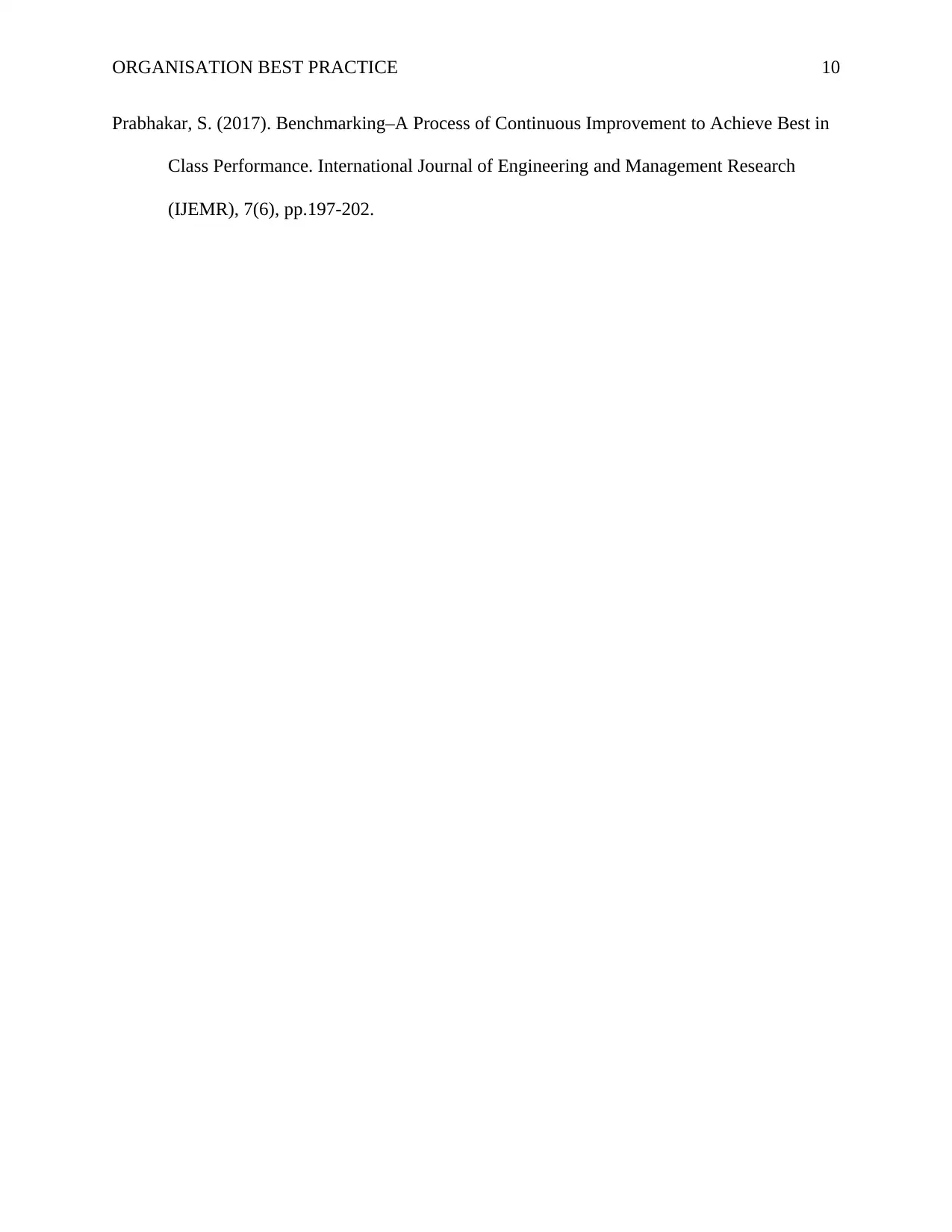
ORGANISATION BEST PRACTICE 10
Prabhakar, S. (2017). Benchmarking–A Process of Continuous Improvement to Achieve Best in
Class Performance. International Journal of Engineering and Management Research
(IJEMR), 7(6), pp.197-202.
Prabhakar, S. (2017). Benchmarking–A Process of Continuous Improvement to Achieve Best in
Class Performance. International Journal of Engineering and Management Research
(IJEMR), 7(6), pp.197-202.
1 out of 10
Related Documents
Your All-in-One AI-Powered Toolkit for Academic Success.
+13062052269
info@desklib.com
Available 24*7 on WhatsApp / Email
![[object Object]](/_next/static/media/star-bottom.7253800d.svg)
Unlock your academic potential
Copyright © 2020–2025 A2Z Services. All Rights Reserved. Developed and managed by ZUCOL.




